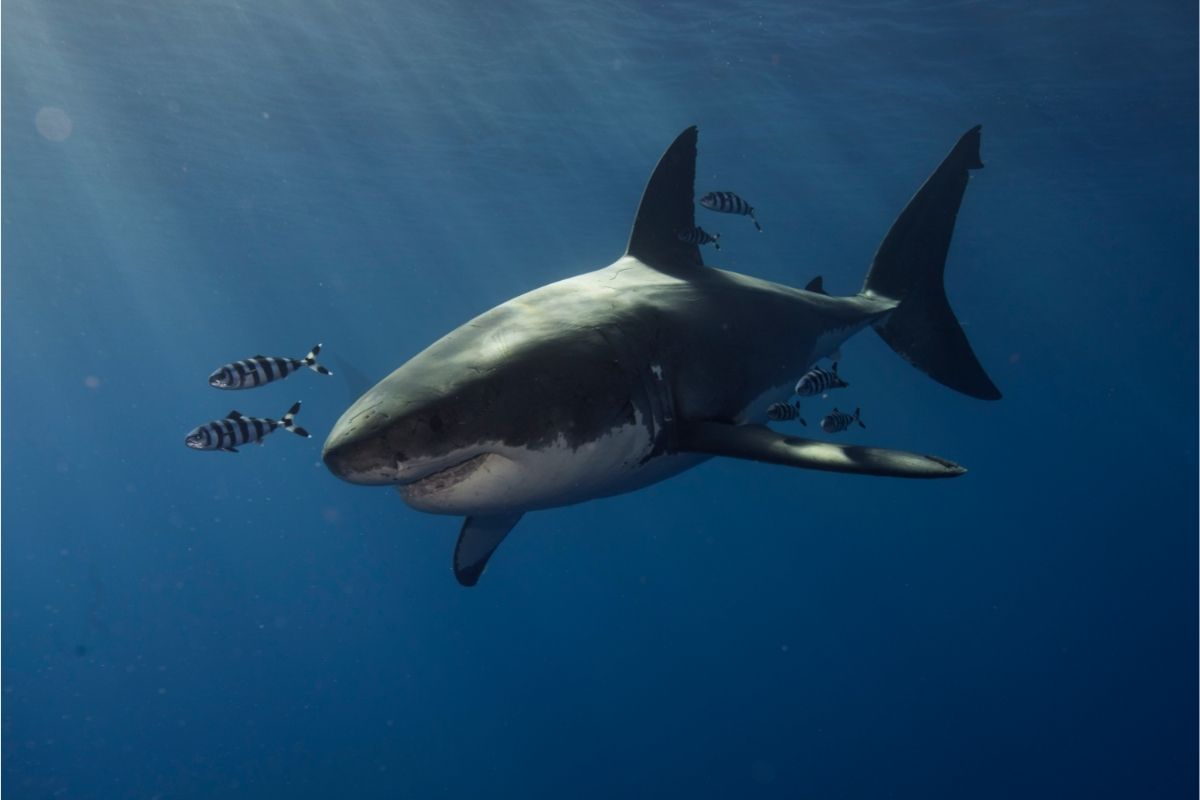The Great White Shark is often thought to be the ultimate underwater predator, as well as one of the apex predators of the animal kingdom in general.
Despite their fearsome reputation, great whites are not at the very top of the aquatic food chain, with predators of their own that can pose a deadly threat.

But what exactly are these predators, and how do great whites defend themselves against them?
In this article, we are going to be taking an in depth look at the predators of the great white shark, as well as take a look at the great white in general to see what makes them so close to being the ultimate apex predator.
The Great White Shark
Before we look at the predators that view the great white shark as prey, it is important to know more about great whites as the incredible creatures that they are.
Great white sharks- also known by their scientific title of Carcharodon carcharias- are as close to an apex predator as it possible to be.
This carnivorous critter became infamous in pop culture following the release of the film Jaws in 1975, earning a fearsome reputation.
However, they are far less threatening to humans in reality (unless you are unlucky enough to come into close contact with them in the water!).
Humans are far from the preferable prey to great whites and shark attacks are exceedingly rare, with fewer than 10 shark attacks usually occurring across the globe within the year.
That being said, it is still not advised to go for a swim in shark infested waters!
These sharks are a species of large mackerel sharks, and they can be found in a wide range of oceans all over the world, though they are more commonly found in coastal surface waters of said oceans.
Great whites are thought to have an estimated life span of 70 years or even longer, which makes them one of the longest living cartilaginous fishes on the planet!
The size of the great white can vary, but some of the larger female great whites, can grow up to 20ft in length with a weight of around 4,000 to 5,000 pounds when they reach maturity.
That being said, there are also smaller females as well as small males. The smaller females tend to grow to between 15 and 16 feet in length on average, whilst the males can grow to around 11 to 13 feet in length.
In terms of speed, the torpedo shaped bodies and strong tails of the great white allow them to propel themselves through the water at high speeds of up to around 35 miles per hour.
This speed allows them to breach the water, which is particularly useful when attacking prey from underneath.
As well as this powerful speed, great whites also have various other traits that make them particularly well adapted to hunting. These include:
- Organs that allow them to sense even the tiniest electromagnetic fields generated by their prey
- Seven rows of 300 serrated, triangular teeth.
- Six highly refined senses: hearing, touch, taste, smell, sight and the aforementioned electromagnetism.
- Incredibly intelligent
- Quick learners
These are just a few of the traits that allow great whites to be such efficient and dominant hunters.
Common Prey to the Great White Shark
Grey white sharks are known for their carnivorous nature, with the following being the most common of their prey:
- Other fish e.g. rays, tuna etc.
- Sea turtles
- Seals
- Sea otters
- Sea birds
- Whales
- Porpoises
- Dolphins
As mentioned, humans are not the preferred snacks of great whites, so whilst there are some unlucky people who have fallen victim to sharks, humans do not make the list of preferable prey to the great white!
The Predators of the Great White Shark
Now that we have a thorough grasp on the various traits of the great white shark and what they favor as their prey, let’s now look at what creature can be considered the biggest predator to the great white shark.

Orcas
Orcas- also known by their more menacing title of killer whales- tend to be known for being in a competition of sorts with great white sharks.
This stems from an overlap of dietary preferences, with both sea creatures having strong similarities in the prey that they seek.
However, the average size of the orca is much larger than the average size of a great white shark, giving orca’s a major advantage in terms of size.
Orcas can be considered a predator of the great white shark, with multiple incidents reported suggesting this. Let’s take a look at a few.
Farallon Islands, 1997
This incident was the very first orca and shark encounter that was documented, occurring in the south-east of the Farallon Islands- just off of the coast of California- in October 1997.
This incident occurred between a female orca- thought to have been sized at between 15 and 17 feet- (though some report that there were two orcas involved) and a great white shark that was thought to be sized between 10 and 13 feet.
The report documents that the orca attacked the shark by holding it upside down, thus inducing toxic immobility.
Due to this, the shark eventually suffocated. The orca then feasted on the dead shark, taking care to ingest the liver- which is located just behind the shark’s pectoral fin- once it had been squeezed out of the sharks’ carcass.
This is likely because of the calorie dense nature of the liver, making it a delicious and nutritious organ for the orca to snack on.
Some reports of this incident state that the attack occurred when a great white shark attempted to take some of the sea lion carcass that the orca was eating.
South Australia, 2015
In 2015, divers in South Australia witnessed a whole pod of orcas kill a great white shark.
The pod was said to have looked to be a whole family of orcas, including two calves!
Those who saw the attack say that the whales were literally “slamming” themselves down upon the shark by launching themselves out of the water and purposely landing on it.
This attack also suggests the intelligence of orcas as well as their ruthlessness, perhaps teaching their young how to take down the shark for future knowledge.
Gansaabi, South Africa, 2017
These incidents are particularly harrowing when it comes to orcas killing great whites! In 2017, three great white sharks were found around the shores of Gansbaai in South Africa.
The state of their carcasses made it obvious that they had been attacked by orcas, with their body cavities entirely torn open, and their livers removed with almost a surgical level of precision.
As well as these incidents, there was also a study published in 2019 that focused on the distribution of both orcas and great white sharks around the Farallon Islands.
This study suggested that orcas were negatively affecting the great white population, as the sharks had been seen to abandon the area after the briefest glimpse of an orca.
This doesn’t necessarily mean that all great whites are scared of orcas- they have often been swimming calmly alongside orcas- but there is no doubt from these incidents that orcas pose the biggest threats to sharks as predators.
Some other predators of great whites can include:
Other Sharks
Great white sharks favor feeding on other marine life, and this can often include their fellow sharks.
A fair amount of time, this cannibalism will occur when a larger shark devours a small one. However, baby sharks- otherwise known as pups- are also a prime feeding source due to their vulnerability.
Pups are not even safe in the womb, as the bigger siblings will sometimes feast on their smaller siblings before they are even born!
Humans
We humans pose a relatively large risk to the great white shark, with research published in the July 2013 Marine Policy journal suggesting that an average of 100 million sharks fall victim to humans every year.
There are a few prominent reasons that cause this, such as ships accidentally crashing into sharks and killing them.
However, most of the deaths of sharks that are caused by humans stem from shark fishing, which is a popular sport in certain areas of the United States such as California and Florida.
The Great White Sharks Defense Against Predators
It is hard to imagine a predator such as a great white shark needing a defense mechanism, but as we can see from what we discussed above, they are certainly needed from time to time!
There are a few specific ways in which sharks will defend themselves when they need to, so let’s take a look at these defenses.
Camouflage
Arguably the most noteworthy defense mechanism of a great white, these sharks are able to camouflage themselves due to their gray backs and white bellies, which is otherwise referred to as countershading.
The white of their stomachs helps them avoid detection from underneath against a light sky, whilst the darker, gray color of their backs allows them to blend with darker ocean waters when seen from above.
Eye Rolling
Sharks are known to roll their eyes backwards before they attack prey, but this is also used when being attacked to protect their eyes from thrashing due to their lack of a nictiating membrane.
Speed
That torpedo shape that we mentioned earlier is not only useful for catching up with prey, it is also handy when a shark finds itself needing to escape a possible attack.
Final Thoughts
Great white sharks are very much the apex predator of the ocean in many ways, but there is no doubt that they can find themselves susceptible to predators at times.
Although their predators are very few in number- mostly consisting of orcas, themselves and humans- we can see from what we have discussed here that even a creature as fearsome as the great white is far from safe in the never ending fathoms of the briny deep!
- Is It Possible For A Shark To Swim Backwards? - August 2, 2022
- Are Leopard Sharks Dangerous? - August 2, 2022
- What Are The Differences Between Shark And Dolphin Fins? - August 1, 2022








